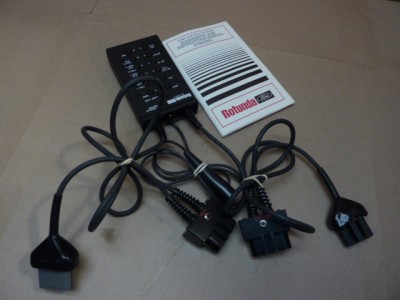 |
| Ford DIS System |
The distributorless ignition system (DIS) for the Ford 2.3L twin spark plug engine consists of the following components:
Crankshaft timing sensor
DIS module
Two ignition coil packs
Spark angle portion of EEC-IV
Crankshaft Timing Sensor
The crankshaft timing sensor is a dual hall effect magnetic switch, which is actuated by the dual vane cup on the crankshaft pulley hub assembly. This sensor generates two separate signals, PIP (profile ignition pick-up) and CID (cylinder identification). The PIP signal provides base timing and RPM information, while the CID signal is used to synchronize the ignition coils. Initial timing (base timing) is set at 10 degrees BTDC and is not adjustable. Ignition Coil Packs

Two ignition coil packs are used for the 2.3L dual plug engine. The two ignition coil packs are triggered by the DIS module and are timed by the EEC-IV. Each coil pack contains two separate ignition coils for a total of four ignition coils. Each ignition coil fires two spark plugs simultaneously, one spark plug on the compression stroke and one on the exhaust stroke. The spark plug fired on the exhaust stroke uses very little of the ignition coils, stored energy, and the majority of the ignition coils, energy is used by the spark plug on the compression stroke. Since these two spark plugs are connected in series, the firing voltage of one spark plug will be negative with respect to ground, while the other will be positive with respect to ground. Refer to thePowertrain Control/Emissions Diagnosis Manual for additional information on spark plug polarity.
DIS Module

The main function of the DIS module is to switch between ignition coils and trigger the coils to spark. The DIS ignition module receives the PIP and CID signals from the crankshaft timing sensor, and the SPOUT (spark out) signal from the EEC-IV module. During normal operation, PIP is passed on to the EEC-IV module and provides base timing and RPM information. The CID signal provides the DIS ignition module with the information required to switch between the coils for cylinders 1 and 4 and the coils for cylinders 2 and 3. The SPOUT signal (from the EEC-IV) contains the optimum spark timing and dwell time information. The dwell time is controlled or varied by varying the duty cycle (duration) of the SPOUT signal. This feature is called CCD (computer controlled dwell). Therefore, with the proper inputs of PIP, CID and SPOUT the DIS ignition module turns the ignition coils on and off in the proper sequence for spark control. CID is also sent to the EEC-IV micro-processor to allow for Bank to Bank fuel control.
Failure Mode Effects Management
During some DIS system faults, the Failure Mode Effects Management (FMEM) portion of the DIS ignition module will maintain vehicle operation. If the DIS ignition module does not receive the SPOUT input, it will automatically turn the ignition coils on and off using the PIP signal. However, this will result in fixed spark timing (ten degrees BTDC) and a fixed dwell time (no CCD). If the DIS ignition module does not receive the CID input during engine cranking, random coil synchronization will be attempted by the module. Therefore, several start attempts (cycling the ignition from OFF to START) may be required to start the engine. If the DIS module loses CID input while engine is running, the module will remember the proper firing sequence and continue to fire to maintain engine operation.
Dual Plug Inhibit
Dual Plug Inhibit (DPI) is a function of the EEC-IV that is only used when the vehicle is being started at temperatures -7° C (20° F) and below. During engine cranking, the EEC-IV will only fire the spark plugs on the right hand side of the engine. When the engine has started, the EEC-IV will send a signal to the DIS module to start normal dual plug operation.
Ignition Diagnostic Monitor
The Ignition Diagnostic Monitor (IDM) is a function of the DIS module. The DIS module sends information on system failures to the EEC-IV which stores the information for diagnostic self test. The IDM signal also is used to drive the vehicle instrument tachometer, and test tachometer for system.
Testing
You can find a good DIS testing procedure using a breakout box
HERE. The factory pinpoint test mentions using a breakout box (BOB). You can do the same test without a breakout box. The BOB just lets you connect to each wire non-intrusively. Without the BOB, you have to locate each wire and probe directly into the wire. The pinpoint tests refer to overlays and test harnesses, just read over the test first and get an idea what the test is checking, and then you can do the test without using the BOB and associated equipment.
 |
| DIS Break out box |











